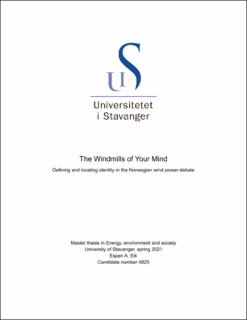| dc.description.abstract | After several years of increasing investments in, and development of, on-shore wind power in Norway, things have come to a standstill. Important industry-leaders all anticipate a prolonged lull, they only differ on whether it will last for “several years” (Malkenes Hovland 2020) or a full decade (Andersen 2020). Things started stalling “in the wake of a failed proposal about which 13 areas in Norway are most suited for wind power” (Pedersen 2021). Debate about the proposal quickly became entrenched. This thesis maps some of those trenches by taking a closer look at the reactions to the proposal.
This is done by using discourse theory to find and describe identity-building story-lines that appear in the hearing answers to the proposal. The thesis shows that earlier research often viewed opposition to such developments as a result of incomplete factual knowledge about wind power. But the identity-building story-lines are not weighing pros and cons to reach a solution. Instead they conjure an “us” that is in conflict with, and usually threatened by, a “them”. Wind turbines and wind power development in general become laden with powerful symbolic meanings. These meanings create a sense of belonging or otherness that can crowd out facts in the discussion.
Four such identity-building story-lines are described. In the “Urban vs. rural” story-line, rural people and landscapes are the victims of an urban elite that reap all the benefits and incur none of the costs of wind power projects. In the “Humiliated Norway” story-line this perspective is moved from rural Norway to the whole country as such, as foreign investors and other nations are seen to be exploiting a naive country. The “Natural Norway” story-line operates more on a strictly symbolic level - here the norwegian landscape is itself laden with meaning and value, and each new wind turbine is a stab at the very heart of a perceived eternal and inherent Norwegian identity. In the “Responsible Norway” story-line there is a twist, as the in-group is the active part. Here, wind turbines are symbols both of a cosmopolitan responsibility, and a penance for carbon-based sins.
Mapping out these identity-building story-lines gives a new perspective on a debate that seems to have completely ground to a halt. This can again give a better understanding of what is at stake for the different actors. | |
